Heitjans P., Karger J. (Eds.). Diffusion in Condensed Matter: Methods, Materials, Models
Подождите немного. Документ загружается.


660 Gerhard N¨agele, Jan K. G. Dhont, and Gerhard Meier
1 − 0.63φ + O(Φ
2
). Thus, memory effects in S
r
(t) lead to a mean diffusion
coefficient only slightly smaller than the short-time one, to first order in Φ.
Whereas a true long-time rotational self-diffusion coefficient, D
r
l
does not
exist in monodisperse suspensions, we expect D
r
l
to be a well-defined long-
time property when interpreted as the long-time coefficient describing the ro-
tation of a large tracer sphere immersed in a dispersion of small host spheres.
Depolarized DLS measurements indicate that a tracer/host size ratio larger
than 10 is large enough for D
r
l
to be well-defined. Due to the separation of
time scales between the slow motion of the tracer and the fast motion of the
host spheres, the tracer experiences the host dispersion as an unstructured ef-
fective fluid, characterized by the effective viscosity η
H
of the host dispersion.
Thus, one expects that D
r
l
obeys the generalized Stokes-Einstein relation for
a perfectly sticking effective fluid, i.e.
D
r
l
=
k
B
T
6πη
H
a
T
, (16.151)
where a
T
denotes the radius of the tracer. This expectation is supported
experimentally, and by calculating the short-time rotational self-diffusion co-
efficient of the tracer in a dilute host dispersion of hard spheres [32]. For the
latter case, D
r
s
is described to good accuracy by [32]
D
r
s
= D
r
0
1 −
2.5
1+3λ
−1
Φ + O(Φ
2
)
, (16.152)
with λ = a
T
/a
H
,andφ the volume fraction of host spheres. This equation
describes a monotonic decline of the tracer coefficient from D
r
s
= D
r
0
at λ =0
towards D
r
s
= D
r
0
(1 − 2.5Φ)=k
B
T/[6πη
0
(1 + 2.5Φ)] + O(Φ
2
)forλ →∞
(see Fig. 16.12). For very large λ, the tracer sphere experiences thus the host
solution as an effective one-component fluid, with an effective shear viscosity
given to first order in Φ by the relation η
H
= η
0
(1 + 2.5Φ). In the opposite
limit λ 1 , the point-like (relative to the host) tracer rotates for short times
in an essentially stationary environment of host spheres so that its dynamic
cage is affected only by the viscosity η
0
of the pure solvent.
16.4 Fluorescence Techniques for Long-Time
Self-Diffusion of Non-Spherical Particles
As explained above, in order to measure self-diffusion properties in a concen-
trated dispersion by means of light scattering, one needs to prepare a sys-
tem, where only a few particles scatter light (the so-called “tracer particles”),
whereas the majority of particles do not contribute to the scattered inten-
sity (the “host particles”). The tracer particles must be so dilute, that they
do not mutually interact, but may interact with the host particles. What is
then measured is the self-diffusion coefficient at a concentration that is equal
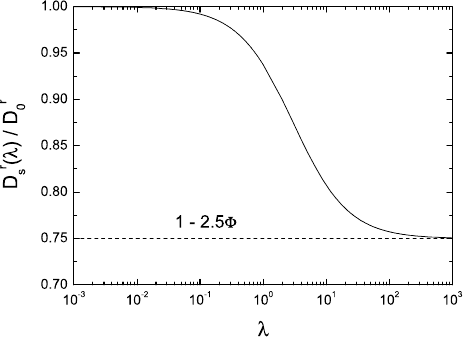
16 Diffusion in Colloidal and Polymeric Systems 661
Fig. 16.12. Reduced short-time self-diffusion coefficient D
r
s
/D
r
0
versus size ratio
λ = a
T
/a
H
of a colloidal tracer sphere immersed in a dilute host dispersion of
colloidal hard spheres. The volume fraction of host spheres is Φ =0.1. After [32].
to the overall concentration. Ideally, the pair-interaction potentials between
the tracer particles and host particles, and mutually between host particles,
are identical. Such a system is difficult to prepare, especially for more com-
plicated colloidal particles such as rods or platelets. In addition, it is not
straightforward to obtain true long-time diffusion coefficients by means of
light scattering. There exist other experimental techniques which allow for a
direct measurement of long-time self-diffusion coefficients, without having to
resort to tracer systems. The techniques which will be discussed here are flu-
orescent recovery after photobleaching (FRAP) and fluorescence correlation
spectroscopy (FCS). Both these techniques require the colloidal particles to
be labelled with fluorescent dyes.
16.4.1 Fluorescence Recovery After Photobleaching (FRAP)
Consider a monodisperse colloidal system, where each colloidal particle is
labelled with a number of fluorescent dye molecules (such as Rhodamine or
Fluoresceine Iso Thio Cyanate (FITC)). These dye molecules can be exited by
a monochromatic incident light beam, and emit light of a larger wavelength
when the exited state of the molecule relaxes to a lower energy state. This
process is called fluorescence. When the intensity of the incident beam is very
high, the structure of the dye molecules is irreversibly changed, and they loose
their fluorescent properties. This process is called bleaching. A bleached dye
molecule does not fluoresce anymore. In the early days of FRAP, diffusion
of free dye molecules was probed, by first bleaching “a hole” in the sample,
by means of a short pulse of high intensity light. Then the intensity of the
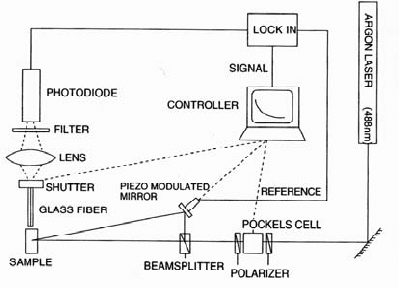
662 Gerhard N¨agele, Jan K. G. Dhont, and Gerhard Meier
Fig. 16.13. Principle of a FRAP setup. Two beams are crossed under an angle
2 Θ. The mirror is mounted on a piezo element, which oscillates with frequency ω
during a measurement. A fiber picks up the fluorescent light that originates from the
sample. The amplitude of the 2ω-component of the fluorescent intensity is filtered
out by means of a lock-in amplifier. From [35].
incident beam was decreased to a level where bleaching is (virtually) absent,
and the fluorescent intensity from molecules within the hole is detected as
a function of time. Due to diffusion of unbleached molecules from outside
the hole into the hole, and of bleached molecules from inside the hole out of
the hole, the fluorescent intensity increases (“recovers”) with time. Once the
geometry of the bleached hole is known, the long-time self-diffusion coefficient
can be obtained from the time dependence of the fluorescent intensity. The
long-time self-diffusion coefficient is measured here, since (i) the fluorescent
intensity from different molecules have no phase relation, so that interference
effects on the measured intensity are absent (contrary scattered radiation),
and (ii) the size of the hole is much larger than molecular dimensions, so that
a significant change in the fluorescent intensity is only measured when the
molecules are displaced over distances that are large compared to their own
size.
The disadvantage of this older version of FRAP is that the geometry of
the bleached volume needs to be known, and that the fluorescent intensity is a
very complicated function of time. Furthermore, for macromolecules that are
labelled, the time required for the fluorescent intensity to recover would be
many hours. The FRAP technique was therefore improved (independently by
two groups [33,34]) by employing a diffraction grating or an interference pat-
tern, respectively. The technique described below uses an interference pattern
created by two crossing laser beams, as sketched in Fig. 16.13.
Instead of just bleaching a hole, a fringe pattern is bleached. To this end,
two laser beams are crossed under an angle 2 Θ,say,whichgivesrisetoa
standing interference pattern in the sample. For the intensity we have

16 Diffusion in Colloidal and Polymeric Systems 663
I
0
(r) ∼ cos{q
0
· r} , (16.153)
where the wavevector q
0
is equal to the difference between the wavevectors
q
1
and q
2
of the two crossed beams
q
0
= q
1
− q
2
. (16.154)
Its magnitude is equal to
q
0
=
4π
λ
sin{Θ} , (16.155)
where λ is the wavelength of the laser beam. We note here, that for the
almost perpendicular incidence of the two beams onto the sample, the ratio
sin{Θ}/λ is independent of whether Θ and λ are both taken equal to their
values within the sample, or in air, in the absence of the sample. Typical
angles are Θ =1
◦
− 5
◦
, corresponding to a fringe spacings in the range
10 −50 µm. The bleach pulse now creates a sinusoidal concentration pattern
of bleached and unbleached particles, as sketched in Fig. 16.14, provided that
the amount of bleached dye molecules is proportional to the incident intensity.
The overall concentration (bleached + unbleached colloidal particles) is
constant. After this bleach of high intensity, the intensity is lowered to a value
where bleaching is virtually absent. Just as in the older version of FRAP, one
could now monitor the recovery of fluorescent intensity with time. The mea-
sured fluorescent intensity, however, is the sum of a background intensity
and a relatively small time dependent contribution. In order to increase the
signal-to-noise ratio of the FRAP experiment, instead, the interference pat-
tern is oscillated with a certain frequency ω and amplitude over the bleached
pattern. This is accomplished by sinusoidal motion of a mirror in Fig. 16.13
that is mounted on a piezo element, whereby the absolute phase of one of
the beams is changed by a phase angle Ψ. This so-called “reading intensity”
is then equal to
I
0
(r,t
) ∼ cos{q
0
· r + Ψ(t
)} , (16.156)
where
Ψ(t
)=A sin{ωt
} . (16.157)
The optimum value of the amplitude of oscillation A will be discussed later.
Since the fluorescent intensity changes when the degree of overlap of the
reading fringes with the bleached fringes changes, the measured fluorescent
intensity oscillates, generally in a complicated fashion. In addition, due to
diffusion the difference in concentration between bleached and unbleached
colloidal particles diminishes with time, resulting in a decreasing amplitude
of the oscillating fluorescent intensity. The precise time dependence of the
fluorescent intensity can be calculated as follows. First of all, the fluorescent
intensity I
f
is proportional to the local incident intensity I
0
(r,t
)andthe
local concentration c
0
(r,t) of unbleached dye molecules (which are attached
to the colloidal particles), summed over the entire sample volume,
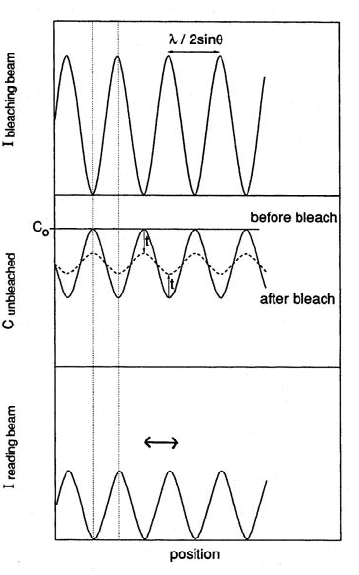
664 Gerhard N¨agele, Jan K. G. Dhont, and Gerhard Meier
Fig. 16.14. The various stages during a FRAP experiment. The top figure is the
intensity of the sinusoidal fringe pattern within the sample. After the bleach pulse,
the concentration of unbleached particles is depicted in the middle figure. The
amplitude of the concentration profile of unbleached particles diminishes with time
due to diffusion. The lower figure depicts the reading intensity with its oscillating
position within the sample. From [35].
I
f
(t
,t) ∼
dr I
0
(r,t
) c
0
(r,t) ∼
dq I
0
(q,t
) c
0
(q,t) , (16.158)
where in the second equation, Bessel’s theorem is used to express the fluo-
rescent intensity in terms of a wavevector integral over the spatial Fourier
transforms of I
0
and c
0
. We made here the distinction between the time de-
pendence t resulting from diffusion and the time dependence t
as a result
of the oscillating interference pattern. The reason for doing so is that the
frequency of oscillation will be assumed large enough, so that over a period
of many oscillations the concentration c
0
(r,t) hardly changes. This will be
important in order to be able to filter a certain time-Fourier component by
means of a lock-in amplifier from the detected fluorescent intensity. During
this filtering, the time dependence due to diffusion must be negligibly small.
Since the spatial Fourier transform of I
0
in (16.156) is

16 Diffusion in Colloidal and Polymeric Systems 665
I
0
(q,t
) ∼ δ(q − q
0
)exp{iΨ(t
)} + δ(q + q
0
)exp{−iΨ (t
)} , (16.159)
where the δ’s are Dirac delta distributions, (16.158) leads to
I
f
(t, t
) ∼ c
0
(q
0
,t)cos{Ψ (t
)} , (16.160)
where we used that c
0
(q
0
,t)=c
0
(−q
0
,t). A time-Fourier analysis of the
fluorescent intensity with respect to its t
-dependence is accomplished by the
mathematical identity
cos{A sin{ωt
}} = J
0
(A)+2
∞
n=1
J
2n
(A)cos{2nω t
} , (16.161)
where J
m
is an m
th
order Bessel function. When the lock-in amplifier is set
to filter the Fourier component with frequency 2ω, its output, according to
(16.160), (16.161), is equal to
S(t) ∼ c
0
(q
0
,t) . (16.162)
S(t) is simply referred to as “the FRAP signal”. In an experiment, the am-
plitude A is chosen such that the corresponding prefactor J
2
(A) in (16.161)
is maximum. Now, since the fringe spacing is much broader than the lin-
ear dimensions of the colloidal particles, the fluorescent intensity diminishes
only when colloidal particles are displaced over distances much larger than
their own size. Hence, long-time diffusion determines the time dependence
of the FRAP signal. Furthermore, since fluorescent intensities from different
dyes have no phase relation, the FRAP signal is not affected by interference
effects, so that self-diffusion in the homogeneous system governs the time de-
pendence. In the long-time limit, the concentration c
0
(r,t) obeys the diffusion
equation
∂c
0
(r,t)
∂t
= D
l
s
∇
2
c
0
(r,t) , (16.163)
where D
l
s
is the long-time self-diffusion coefficient. The assumption here is
that bleaching has no effect on the pair-interaction potential between the
colloidal particles. Hence,
∂c
0
(q,t)
∂t
= −D
l
s
q
2
c
0
(q,t) (16.164)
and
c
0
(q,t) ∼ exp{−D
l
s
q
2
t} . (16.165)
From (16.162) one thus obtains the following simple relationship between the
FRAP signal and the long-time self-diffusion coefficient:
S(t) ∼ exp{−D
l
s
q
2
0
t} . (16.166)
666 Gerhard N¨agele, Jan K. G. Dhont, and Gerhard Meier
The nice feature about the improved FRAP technique is that the concentra-
tion profile of unbleached colloidal particles remains sinusoidal throughout
its relaxation, since the sine-function is an eigenfunction of the operator on
the right hand-side in (16.163). This feature leads to the single-exponential
behaviour of the FRAP signal in (16.166). This must be contrasted with the
concentration profiles during relaxation in the older version of FRAP, where
simply a hole is bleached, leading to a Gaussian-like concentration profile af-
ter the bleach pulse. Such a Gaussian-like concentration dependence is not an
eigenfunction of the operator in (16.163), leading to a much more complicated
time dependence of the fluorescent intensity during recovery as compared to
the decay of the FRAP signal in (16.166) for the improved FRAP technique.
The above analysis is a simplified version of a much more elaborate analy-
sis as given in [35].
Long-Time Self-Diffusion of Colloidal Rods
The analysis given above holds for colloidal particles of any shape, as long
as their linear dimensions are small compared to the fringe spacing. Experi-
mental results on spherical colloids (and mixtures of spheres of various sizes)
will be discussed later. In the present subsection we shall discuss FRAP ex-
periments on stiff, colloidal rods, which are taken from [36–38].
Two colloidal systems are discussed here. The first system consists of
boehmite rods, where the aluminium core is covered with aluminium chloro-
hydrate (Al
2
(OH)
5
Cl 2 −3H
2
O, ACH), to partly shield the van der Waals
attractions between the cores [38]. The aspect ratio, corrected for the ACH
layer thickness and charges of these rods is L/D =7.3(whereL = 257 nm is
the length of the rods, and D their effective thickness). The solvent is water,
with 0.01 M added NaCl. This system will be referred to as “system I”. The
second system consist of boehmite rods, where the aluminium core is cov-
ered with a ∼ 25 nm thick layer of SiO
2
, which virtually completely screens
the van der Waals interactions [37]. The aspect ratio, corrected for charge
repulsion, is equal to L/D =5.4(withL = 323 nm). This system will be
referred to as “system II”. The solvent here is DMS with 0.01 M LiCl added.
The polydispersity in both systems is around 30 % in length and 20 % in
thickness. Both systems exhibit an isotropic-nematic (i-n) phase transition.
Typical FRAP data are shown in Fig. 16.15, together with a single-
exponential fit (the solid lines) according to (16.166). The two sets of data
correspond to a measurement in an isotropic state and the coexisting nematic
state, where diffusion along the director is probed.
A reliable value for the long-time diffusion coefficient, accurate to within
a few percent, is obtained when 10 to 20 such measurements are averaged.
Clearly there is a large difference between the long-time diffusion coefficients
in the isotropic phase and the coexisting nematic phase. Within the nematic
state, where the orientation of the rods has a preferred direction, which is
referred to as the director, two kinds of diffusion coefficients can be probed:
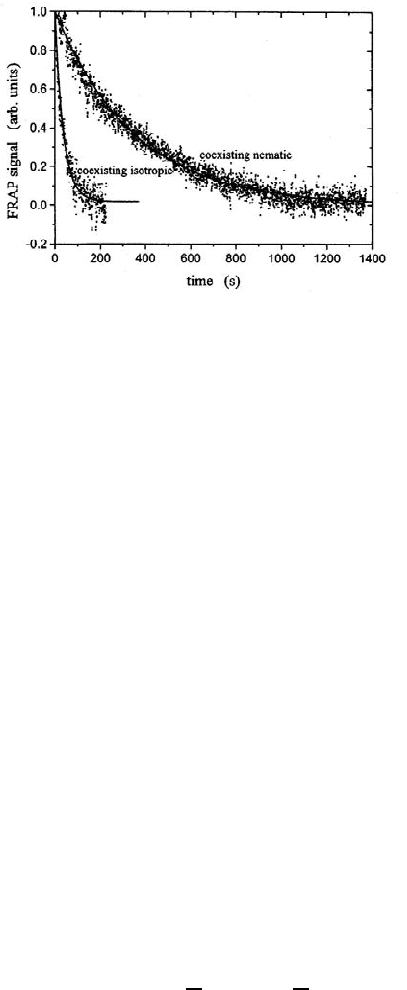
16 Diffusion in Colloidal and Polymeric Systems 667
Fig. 16.15. Typical FRAP curves (for system I). The two curves are for the nematic
state, where diffusion along the director is probed, and the coexisting isotropic state.
After [36, 38].
diffusion along the director and perpendicular to the director. In order to be
able to measure these two coefficients, the wavevector q
0
in (16.154) must
be chosen either along or perpendicular to the director. The corresponding
FRAP geometries are sketched in Fig. 16.16, where the z-axis is along the
director.
Long-time diffusion coefficients for system I are plotted in Fig. 16.17 as a
function of the bare volume fraction (where the thickness is not corrected for
the ACH layer thickness and charges). As can be seen, the long-time diffusion
coefficients within the nematic phase are an order of magnitude smaller than
for the coexisting isotropic phase. Furthermore, the long-time self-diffusion
coefficient D
nem,
for diffusion along the director is about twice as large as
the coefficient D
nem,⊥
for diffusion in directions perpendicular to the director.
Side-wise diffusion is thus two times slower than length-wise diffusion in the
nematic phase. This kind of behaviour seems to be very sensitive on flexibility
and/or the presence of charge interactions [39].
For low concentrations, in the isotropic state, the long-time diffusion co-
efficient can be expanded with respect to the (effective) volume fraction Φ
as
D
l
s
= D
0
+
1 − αΦ+ O
Φ
2
,
. (16.167)
On the basis of a variational approach for spherically end-capped cylinders
with hard-core interactions, the aspect-ratio dependence of the coefficient α
is predicted to be equal (to within about 5 %) to [41]
α =2+
10
32
(p − 1) +
1
53
(p − 1)
2
,p≤ 30 , (16.168)
where p = L/D is the aspect ratio. Here, hydrodynamic interactions have
been neglected. For p = 1, that is for spherical particles, we have α =2.
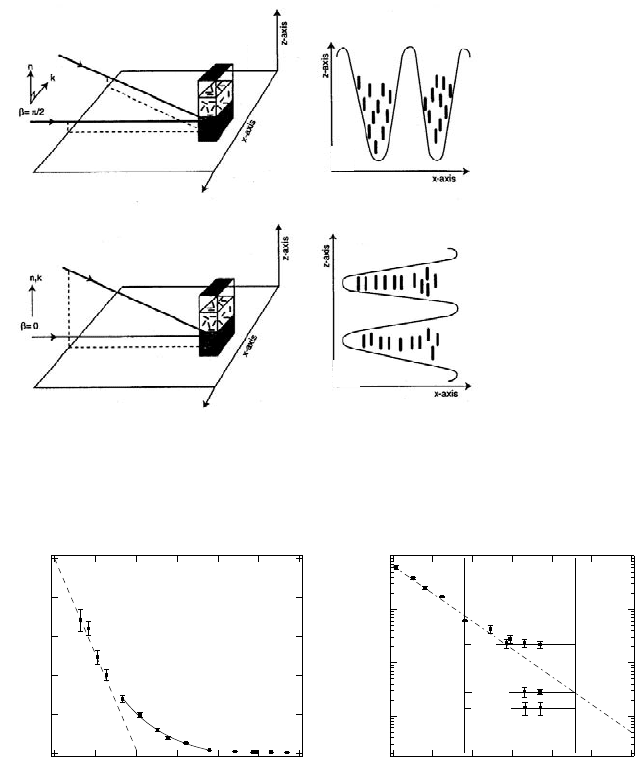
668 Gerhard N¨agele, Jan K. G. Dhont, and Gerhard Meier
(a)
(b)
Fig. 16.16. FRAP geometries for the measurement of diffusion coefficients per-
pendicular to the director (a) and parallel to the director (b). The figures on the
right depict the orientation of the fringe patterns relative to the director (which is
along the z-axis). After [36, 38].
1.0
0.8
0.6
0.4
0.2
0.0
D
s
l
/
D
0
30x10
-3
25201510
50
Φ
a)
10
-2
10
-1
10
0
D
s
l
/
D
0
40x10
-3
35
3025201510
Φ
ISOTROPIC
ISOTROPIC
+
NEMATIC
NEMATIC
b)
D
iso
D
nem, ||
D
nem,
⊥
Fig. 16.17. Long-time self-diffusion coefficients for system I, as functions of the
bare volume fraction in the isotropic state (a), and up to volume fractions within
the i-n coexistence region (b). Diffusion coefficients are normalized to the Stokes-
Einstein diffusion coefficient D
0
. After [36, 38].
Including hydrodynamic interactions changes this value to 2.10 [1, 42, 43].
Since for rod-like particles the volume fractions of interest are lower than
those for spheres, this indicates that hydrodynamic interactions do not very
much affect values for long-time self-diffusion coefficients.
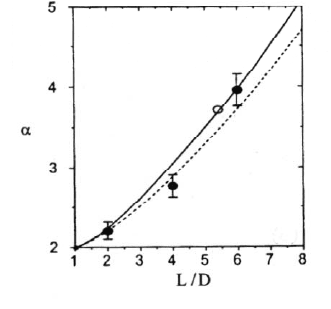
16 Diffusion in Colloidal and Polymeric Systems 669
Fig. 16.18. The coefficient α, defined in (16.168), as a function of the aspect ratio
p = L/D. The two curves are the result of a variational principle where a very
simple trial function is used (dotted line) and a more involved trial function (solid
line). The solid data points are computer simulation results from [40]. The open
circle is the FRAP result for system II. After [36, 37].
Experimental FRAP results for system I are not in accordance with this
theoretical prediction. Probably the 2 nm thick ACH layer does not effectively
screen van der Waals attractions (a theoretical estimate for the minimum
layer thickness to fully screen van der Waals attractions of the aluminium
cores in water is about 20 − 30 nm). For the boehmite rods with the 25 nm
thick silica coating, system II, FRAP data are found to be in accordance
with the prediction in (16.168). The prediction (16.168), together with the
FRAP result for system II (open circle) and computer simulations (solid
data points) are plotted in Fig. 16.18. The two curves are the result of the
variational principle where a very simple trial function is used (dotted line)
and where a more involved trial function is used (solid line) [41]. It remains a
theoretical challenge to predict diffusion coefficients at higher concentrations,
including the i-n coexistence region.
More FRAP data, for spherical particles, will be discussed later.
16.4.2 Fluorescence Correlation Spectroscopy (FCS)
In fluorescence correlation spectroscopy one measures the fluorescent inten-
sity that originates from a small, relatively strongly illuminated volume. Here,
a single laser beam is strongly focussed, and by means of confocal optics, the
fluorescent intensity is measured from a region around the focal point, the
so-called “confocal volume”. The confocal optics is sketched in Fig. 16.19,
and explained in the caption.
The intensity distribution within the confocal volume is well represented
by a Gaussian profile,
